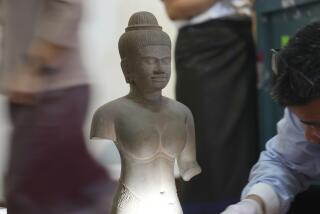Carrying on a Lyrical Legacy
- Share via
The annihilation of ancient cultural traditions may continue in such places as Afghanistan, but the Cambodian people offer an inspiring example of how to reclaim and, where necessary, reconstruct lost glories of a fabled past after a virtually unimaginable holocaust.
Out of the ashes of the brutal Pol Pot/Khmer Rouge era in the late 1970s, the richness of Khmer culture has reemerged, lovingly pieced together and currently represented by a 12-city U.S. tour of “Dance, the Spirit of Cambodia,” a project of Phnom Penh’s University of Fine Arts.
In a well-attended sampler program Wednesday at the Carpenter Center in Long Beach, introductory remarks linked the disasters of Cambodia’s recent past with the terrorism everyone is talking about this week. To negate both kinds of barbarism, the sculptural purity of classical dance shared the evening with the lusty vigor of selections drawn from the folk repertory. In addition, a nine-member ensemble of singers and instrumentalists provided its own dimension of refinement and, indeed, the suite of woodwind solos performed by Nol Soboun proved one of the evening’s highlights.
However the program as a whole suffered from a misconceived emphasis on grandiose spectacle, an emphasis that left much of the dancing impossible to see at its proper scale. Dating from a culture that flourished from the ninth to the 13th centuries, Khmer classical dances that originated as court entertainments depend on a wealth of details: the curving back of hands and feet, the splaying of fingers, the intricate shifts of head and shoulders. Indeed, some of the most intimate and expressive solos take place in a kneeling position on a low bench.
At the Carpenter Center, this bench was placed even with the last upstage wing: about as far away from the audience as you could get and still be in front of the backdrop.
Bathed in Clifton Taylor’s washes of colored light and set against panoramic sepia slides, the effect was pictorially impressive but ruinously remote and so theatrically glazed that the physical immediacy of dance was virtually lost.
As a result, the act-long excerpt from “Reamker” (a.k.a. “Ramayana”) had far less impact than performances of the same narrative epic by different major Cambodian ensembles at the Los Angeles Festival in 1990 and at the India International Dance Festival in New Delhi the same year.
The dancers proved blameless, and, in particular, the women’s candle dance symbolizing Sita’s trial by fire and Sam Sathya’s solo in the same sequence showed how truly exquisite Khmer lyricism can be. But where was the sense of theater that even technically unfinished expatriate Cambodian American companies have brought to this classic tale?
Throughout south and southeast Asia, the end of “Ramayana” can make you weep with its triumphant restoration of peace, social order and family unity. The spiritless “Spirit of Cambodia” version, however, left you with only one more artfully arranged group exit to watch--at long distance.
Happily, the folk pieces communicated more strongly--especially the celebratory village ensemble “Chhayam,” which began in the auditorium and developed into a suite of mask-and drum-dances incorporating broad physical comedy, flashy gymnastics and the flirtatious byplay of Chhim Sokha, Yorn Tom and the others.
In “Robam Tunsaong,” Ourn Sophon and Sok Tong portrayed wild oxen, reinforcing the powerful rhythms of the piece with hand pulses and steps performed in crouching or squatting positions. Performers cast as a hunter, a tiger and a bumblebee figured in the dancing and provided the musical accompaniment, but the oxen duet remained the compelling choreographic focus.
The company’s folk dancers also played the monkey army in “Reamker,” though their leaders, Soeur Thavarak and Pum Bun Chanrath, were drawn from its classical ranks. Especially prominent in those ranks: Sok Sokhoeun, a dancer of impressive delicacy in “Robam Apsara,” a piece evoking the dance sculptures throughout the great 12th century temple of Angkor Wat.
Seeming to step from a niche in that temple, Sokhoeun created an image of unearthly poise through floating walks, delicate rotations of the arms and serene balances on one leg.
The glittery costume spectacle of “Robam Makar” may have been more conventionally dazzling, but something in her performance put the essence of a rescued national legacy front and center in all its brilliance.
Besides the dancers mentioned, major soloists Wednesday included Khieu Sotheavy, Ros Yaran, Ouk Solichumnith and Bouth On.
More to Read
The biggest entertainment stories
Get our big stories about Hollywood, film, television, music, arts, culture and more right in your inbox as soon as they publish.
You may occasionally receive promotional content from the Los Angeles Times.










